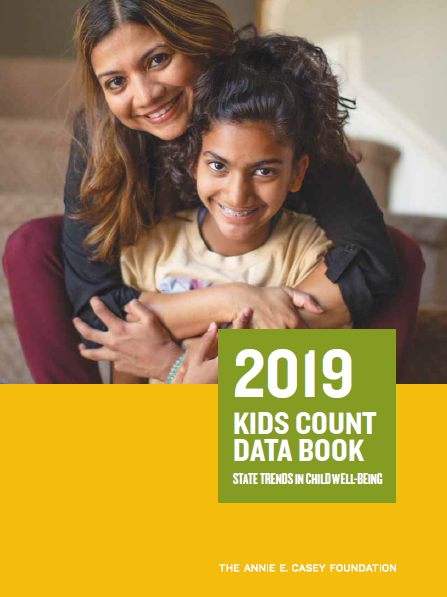KIDSCount Data Book 2019
Each year, the Annie E. Casey Foundation releases its KIDS COUNT Data Book, a resource that gathers information on various factors affecting the well-being of children in the United States. The report is accompanied by a data center that allows users to view data on trends in their states as well as nationwide.
The 2019 edition of the KIDSCount Datab Book marks the 30th anniversary of the Data Book and includes a section that looks at how being a child in America has changed since 1990. America’s children are much more diverse, with children of color making up 47% of the child population in 2017 versus 31% in 1990. The teen birth rate fell 68%, the percentage of children without health insurance dropped 62% and the percentages of children 3 and 4 years of age attending preschool and of teens graduating from high school have both increased. In fact, conditions have improved in 11 of the 16 areas of child well-being that the foundation tracks since the first data book was published in 1990.
The rest of the Data Book looks at the period 2010-2017 to track state-level and national trends across four categories: economic well-being, education, health, and family and community. Here are some highlights of what it found for 2019:
- Economic Well-Being: The number of children living in poverty declined slightly, from 225 to 18% and children living in households with a high housing cost burden declined 10%, from 41% of children to 31%.
- Education: While the number of fourth graders not proficient in reading declined slightly and the number of eighth graders not proficient in math stayed steady, these percentages are still quite high, at 65% and 67%, respectively.
- Health: This category had the only indicator that worsened. The number of low birth weight babies actually increased from 2010 to 2017. Other indicators in this category, including the number of children without health insurance and number of teens abusing alcohol or drugs, improved.
- Family and Community: The most marked improvement in this category was a drop in teen births, from 34 to 19 per 1,000 population.
Despite a general, if modest, trend of improvement across most of the 16 indicators, the report’s authors caution there is still much work to be done to improve child well-being in communities throughout America. The report includes a call to action to ensure the next census accurately counts children, particularly those who are members of vulnerable populations, and to use the data in the report to craft effective policies targeting child well-being.
Read the KIDS COUNT Data Book 2019.
Explore national and state-level data in the KIDS COUNT Data Center.
